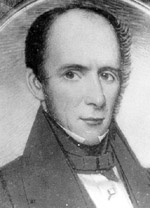
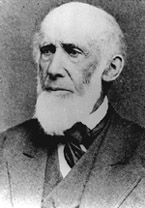


John B. Jervis (1795-1885) was America's leading consulting engineer of the antebellum era (1820 - 1860). Jervis was a pioneer in the development of canals and railroads for the expanding United States. He designed and supervised the construction of five of America's earliest railroads, was chief engineer of three major canal projects, designed the first locomotive to run in America, designed and built the forty-one mile Croton Aqueduct (New York City's water supply for fifty years: 1842 - 1891), and the Boston Aqueduct. Jervis authored a book on economics, The Question of Labor and Capital (1877); helped found a local industry, the Rome Iron Mills; and, of course, is the founder of Rome's public library.
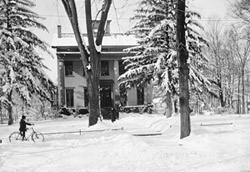 Jervis
bequeathed his home and personal library to the city of Rome, New York, to be
used as a public library. His personal library is kept intact as a memorial and
for research purposes. The papers of John Jervis number in the thousands, and
include memoirs, manuscripts of books he authored, scrapbooks, folios and
quartos, nearly 600 engineering plans and drawings (some in watercolor), maps,
public documents, and countless letters and reports. His library also includes
1,800 monograph volumes on general topics as well as a concentration on applied
sciences and civil engineering. Copyrights and dates of publication range from
the 1670's through the 1880's.
Jervis
bequeathed his home and personal library to the city of Rome, New York, to be
used as a public library. His personal library is kept intact as a memorial and
for research purposes. The papers of John Jervis number in the thousands, and
include memoirs, manuscripts of books he authored, scrapbooks, folios and
quartos, nearly 600 engineering plans and drawings (some in watercolor), maps,
public documents, and countless letters and reports. His library also includes
1,800 monograph volumes on general topics as well as a concentration on applied
sciences and civil engineering. Copyrights and dates of publication range from
the 1670's through the 1880's.
Jervis began his career in Rome as an Axeman for an Erie Canal survey party in 1817. By 1823 he was superintendent of a fifty-mile section of the Erie Canal. In 1827 he was appointed Chief Engineer of the Delaware and Hudson Canal project. It was John Jervis who suggested that a railroad be incorporated into this project. At this time there were no railroads in America, but Jervis won approval of his idea and even designed the railroad's locomotive, the Stourbridge Lion, the first locomotive to run in America. In honor of his work on the Delaware and Hudson, Port Jervis, N.Y., is named for him.
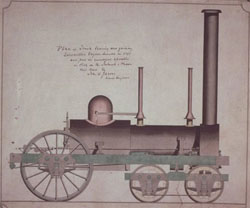 In
1830, as Chief Engineer of the Mohawk & Hudson Railway (the first section of
what was later to be the N.Y. Central R. R.), Jervis designed "The
Experiment." This was the first locomotive in the world to have a
free-swinging, four-wheel front truck, which gave the vehicle greater
maneuverability and enabled it to travel at an unprecedented speed of eighty
miles per hour. The Jervis design became the standard American design.
In
1830, as Chief Engineer of the Mohawk & Hudson Railway (the first section of
what was later to be the N.Y. Central R. R.), Jervis designed "The
Experiment." This was the first locomotive in the world to have a
free-swinging, four-wheel front truck, which gave the vehicle greater
maneuverability and enabled it to travel at an unprecedented speed of eighty
miles per hour. The Jervis design became the standard American design.
The monumental task of building New York City's forty-one mile water-supply system (The Croton Aqueduct) was given to Jervis in 1836. The system included the Croton Dam, the Ossining Bridge, the Harlem River Bridge, the Receiving, Equalizing, and Distributing Reservoirs on Manhattan, as well as the magnificent embankments, tunnels, and arches employed throughout the aqueduct system. (Original illustrations and engravings of these structures are preserved in the Smithsonian Institution and in the Library of Congress). The six-year project employed over 4,000 workers, and when completed, carried seventy-five million gallons daily to New York City.
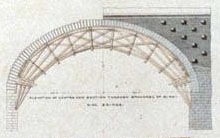 Jervis's
other notable contributions include the design and construction of the
following: the ninety-eight mile Chenango Canal (1833), the enlargement of the
eastern division of the Erie Canal (1834), the Boston water supply project
(1846), the Hudson River R. R. (1847-1850), the Michigan Southern & Northern
Indiana R.R., the Chicago & Rock Island R.R. (1850 - 1858), and he was
general Superintendent of the Pittsburgh, Fort Wayne & Chicago Railway
(1861-64). Again, we must stress that these undertakings were
"pioneering" ventures. Jervis's projects were filled with
"first" and "untried" engineering principles, and as such,
were "schools" for a generation of American civil engineers.
Jervis's
other notable contributions include the design and construction of the
following: the ninety-eight mile Chenango Canal (1833), the enlargement of the
eastern division of the Erie Canal (1834), the Boston water supply project
(1846), the Hudson River R. R. (1847-1850), the Michigan Southern & Northern
Indiana R.R., the Chicago & Rock Island R.R. (1850 - 1858), and he was
general Superintendent of the Pittsburgh, Fort Wayne & Chicago Railway
(1861-64). Again, we must stress that these undertakings were
"pioneering" ventures. Jervis's projects were filled with
"first" and "untried" engineering principles, and as such,
were "schools" for a generation of American civil engineers.
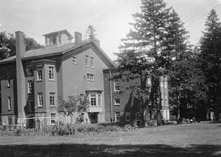 Jervis
returned home to Rome in 1864. In 1869 he organized the Merchants Iron Mill,
which survives today as the Rome Iron Mill. He spent the remainder of his life
writing and in 1877 published a book on economics, The Question of Labor and
Capital. Upon his death he bequeathed a large portion of his estate to the
city of Rome for a library. His personal library remains as a special collection
in Rome's Jervis Library. A Library of Congress representative noted that it is
one of the most complete sets of early railroad and canal reports and maps in
existence.
Jervis
returned home to Rome in 1864. In 1869 he organized the Merchants Iron Mill,
which survives today as the Rome Iron Mill. He spent the remainder of his life
writing and in 1877 published a book on economics, The Question of Labor and
Capital. Upon his death he bequeathed a large portion of his estate to the
city of Rome for a library. His personal library remains as a special collection
in Rome's Jervis Library. A Library of Congress representative noted that it is
one of the most complete sets of early railroad and canal reports and maps in
existence.
Rome NY August 1999
Bibliography prepared by Keith Kinna, Jervis Public Library, Rome, NY 13440.